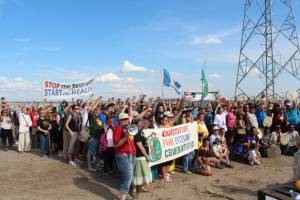 In 2014 Naomi Klein popularized the term “blockadia” in her book This Changes Everything using the term as a sort of catch-all to describe the grassroots insurgency emerging across the globe in the face of extreme energy development. This past year also saw the continued desperate push by tar sands peddlers to build more pipelines, new mines and rush to dig up every last drop of tar sands crude. Thankfully, community opposition from the source to every coast (and even across the Atlantic in Europe, where protests met the arrival of the first shipment of tar sands to Europe) has risen up. As we leave 2014 and look forwards to 2015, here is a snapshot of the global movement to stop the tar sands.
In 2014 Naomi Klein popularized the term “blockadia” in her book This Changes Everything using the term as a sort of catch-all to describe the grassroots insurgency emerging across the globe in the face of extreme energy development. This past year also saw the continued desperate push by tar sands peddlers to build more pipelines, new mines and rush to dig up every last drop of tar sands crude. Thankfully, community opposition from the source to every coast (and even across the Atlantic in Europe, where protests met the arrival of the first shipment of tar sands to Europe) has risen up. As we leave 2014 and look forwards to 2015, here is a snapshot of the global movement to stop the tar sands.
The Source
Just a few short years ago the Northern Alberta tar sands were a little known unconventional oil reserve. Not anymore, thanks to the tireless efforts of activists & community leaders from Indigenous communities downstream of the tar sands. Projects like the Healing Walk, the final walk that happened this past June, have brought global awareness to one of the world’s largest and most dangerous pools of carbon.
This year saw three major tar sands projects shelved. Shell, Total and Stat-Oil all suspended projects that previously had been seen  as “done deals” because of a lack of market access, financial uncertainty and rising opposition. With the falling price of oil, and the world waking up to the reality of the carbon bubble, this could be just the beginning for financial trouble in the tar sands. In 2015, new projects like Teck’s Frontier Mine – the largest open pit tar sands mine ever proposed – could become a litmus test for the future of new tar sands developments, and a turning point to stopping tar sands at the source.
as “done deals” because of a lack of market access, financial uncertainty and rising opposition. With the falling price of oil, and the world waking up to the reality of the carbon bubble, this could be just the beginning for financial trouble in the tar sands. In 2015, new projects like Teck’s Frontier Mine – the largest open pit tar sands mine ever proposed – could become a litmus test for the future of new tar sands developments, and a turning point to stopping tar sands at the source.
In 2014 the fight to stop tar sands at the source took on new energy as potentially game-changing legal actions from the Athabasca Chipewyan First Nation & Beaver Lake Cree Nation took center stage. Both legal challenges have the potential to stop tar sands development in it’s tracks as tar sands companies and the Canadian government could be forced to respect Indigenous rights and honour the treaties.
The West Coast
2014 went out like a lion on the West Coast when Burnaby Mountain became a flashpoint for the climate justice movement. When RCMP raided a months-long encampment organized by the Burnaby Mountain Caretakers to stop Kinder Morgan from perfuming testing activities on Burnaby Mountain (activities they were forced to do because of community opposition to the existing route) to enforce an injunction they set off days of civil disobedience ending in over 100 arrests of people standing up for the climate and Indigenous rights.
This was just one moment in a year where community opposition to the Kinder Morgan took shape, with pockets of resistance  emerging all along the pipeline route from the T’seil Watuth Nation building renewable energy across the Burrard Inlet from the pipeline end, to the Secwepemc Women Warrior Society disrupting meetings and challenging the pipeline in the Interior.
emerging all along the pipeline route from the T’seil Watuth Nation building renewable energy across the Burrard Inlet from the pipeline end, to the Secwepemc Women Warrior Society disrupting meetings and challenging the pipeline in the Interior.
Earlier in the year the National Energy Board and Stephen Harper’s cabinet both gave their approval for Enbridge’s Northern Gateway pipeline. The decision sparked dozens of demonstrations with thousands of people taking to the streets, and drew a clear line that if the federal government wants to build this pipeline, they’re going to need to go through a slew of communities in opposition. Most recently over $300,000 was raised to support a wall of First Nations legal challenges to the pipeline.
On the West Coast of the United States fierce community opposition to coal trains found a new fight as communities have fought off plans to ship oil by rail, including potential tar sands exports. Despite the relentless attempts of tar sands and pipeline companies to drive the pipeline vs. rail debate, tar sands by rail remains a marginal industry and one that is already proving cost-prohibitive. Still, community opposition, like what has emerged on the US West Coast, is blocking what little options there are for expanding tar sands by rail.
The East Coast
Probably the biggest development in 2014 was TransCanada’s filing of their 1.1 million barrel per day “Plan B” for Keystone XL – the Energy East Pipeline. Considered by many to one of the easiest pipelines to win approval for, Energy East has become mired in resistance. Called a “nation builder” by many proponents it’s proving to be better at building a nation of resistance to the project. Already TransCanada has had plans to build an export terminal in Cacouna, QC all but scuttled and faces a Quebec population that is overwhelmingly opposed to the project. Dozens, if not hundreds, of community groups have emerged to oppose to project from Saskatchewan all the way to New Brunswick, including the Coule Pas Chez Nous network in Quebec, a network of rural community groups that raised nearly half a million dollars in a few short days to stop the project in late 2014.
Indigenous opposition to the project also continues to grow. Organizers in Manitoba and Western Ontario have disrupted TransCanada events and called out collaboration between Indigenous leaders and TransCanada. nI Quebec, community members from Kanastahke – the site of the 1990 Oka Blockade, which will see it’s 25th anniversary this year – issued a declaration opposing the pipeline.
events and called out collaboration between Indigenous leaders and TransCanada. nI Quebec, community members from Kanastahke – the site of the 1990 Oka Blockade, which will see it’s 25th anniversary this year – issued a declaration opposing the pipeline.
Potentially most importantly going into 2015, Energy East has also become a lightning rod for connecting tar sands pipelines and Stephen Harper’s refusal to deal with the reality of climate change. Over 60,000 people have already demanded that the National Energy Board review the project’s upstream climate impact, and a growing chorus of organizations & experts is echoing that call. Between the pressure on Energy East, and the fact that many of those arrested on Burnaby Mountain cited the NEB’s refusal to consider climate change as their motivation, it’s clear that in 2015 reviewing pipelines without considering their full climate impact won’t fly.
In 2014 the Line 9 pipeline also faced fierce opposition, including a number of blockades and occupations of worksites on the Enbridge pipeline route in both Ontario & Quebec, a legal challenge from the Chippewya of the Thames and most recently, a rejection from the Mayor of Montreal.
In July the Tar Sands Free Northeast campaign scored a major win shredding industry plans for shipping tar sands from line 9 in Montreal to the port in Portland Maine. The coalition passed a rock solid ordinance banning the building of any new tar sands related infrastructure for the Portland Montreal Pipe Line.
South
In late 2014, after over 300,000 people marched through the streets of New York demanding real action on climate, big oil politicians in the US Senate and Congress tried to push through an approval of the Keystone XL. Their push failed and seems to have emboldened US President Barack Obama against the project as we head in 2015, which could be a decisive year for the fate of the Keystone pipeline.
After the world took notice of the growing rural resistance and alliance between landowners and Indigenous peoples in the United  States at Reject & Protect, resistance has continued to build all along the pipeline route. This past year saw the emergence of NoKXL Dakota, an alliance between Dakota Rural Action and Oceti Rising that is working to “protect our land and water in this territory against tar sands and dirty oil”. In Nebraska, the pipeline has no legal route and the case is currently in front of the State Supreme Court. No matter the decision from the court the movement in Nebraska is ready, having grown bigger and bolder in 2014 with events like the Harvest the Hope concert. This rural resistance was just one part of the story in 2014 with hundreds of actions happening all across the United States, like the XL Dissent action that saw hundreds of youth and students arrested at the White House to stop the pipeline.
States at Reject & Protect, resistance has continued to build all along the pipeline route. This past year saw the emergence of NoKXL Dakota, an alliance between Dakota Rural Action and Oceti Rising that is working to “protect our land and water in this territory against tar sands and dirty oil”. In Nebraska, the pipeline has no legal route and the case is currently in front of the State Supreme Court. No matter the decision from the court the movement in Nebraska is ready, having grown bigger and bolder in 2014 with events like the Harvest the Hope concert. This rural resistance was just one part of the story in 2014 with hundreds of actions happening all across the United States, like the XL Dissent action that saw hundreds of youth and students arrested at the White House to stop the pipeline.
This past year also was the coming out party for the movement against the Alberta Clipper pipeline. In August, organizers discovered Enbridge had devised an illegal scheme to get around the permitting process for the Clipper pipeline. Not content to wait for the legally required federal permitting process and environmental review, Enbridge wants transfer the dirty tar sands crude from Alberta Clipper to another pipeline, Line 3, just north of the border, then re-transfer it back to Alberta Clipper once it’s crossed into the United States. The move has already sparked strong opposition and an impending legal challenge.
Also in the Midwest, orgaing being led by Honour the Earth is taking on the Sandpiper pipeline, another Enbridge proposal that could carry fracked Bakken crude or tar sands. Taking action to protect the land, water and wild rice beds in the region, local opposition has forced an extension of the public comment period on the project and is gearing up for more in the coming year.
Solutions
If 2014 was the year of the pipeline fighter, the coming storm in 2015 could land on financial bottom line of the tar sands. With the price of oil continuing to plunge, opposition showing no signs of abating, and legal challenges to new projects in Alberta moving forwards the once “inevitable” development of the tar sands is looking shakier and shakier. Fossil Free Indexes, the group responsible for determining the top 200 companies by proven carbon reserves used by the divestment movement, recently published a list of the top 20 worst tar sands companies stating that “growth of potential CO2 emissions from oil sands has far  outstripped the growth of oil and gas emissions overall” and that “falling oil prices will cause proved tar sands reserves to be revised down”. In other words, tar sands investments aren’t just morally risky anymore, they’re financially risky too. Stephen Harper’s relentless agenda of tar sands development could become a major economic liability in 2015 and the economic fallout of a world moving to renewables while Canada refuses to act on climate is should fall squarely on his shoulders.
outstripped the growth of oil and gas emissions overall” and that “falling oil prices will cause proved tar sands reserves to be revised down”. In other words, tar sands investments aren’t just morally risky anymore, they’re financially risky too. Stephen Harper’s relentless agenda of tar sands development could become a major economic liability in 2015 and the economic fallout of a world moving to renewables while Canada refuses to act on climate is should fall squarely on his shoulders.
In the midst of this, without any significant federal government support, a clean energy revolution is also underway in Canada. Over the past five years $25 billion has been moved into the clean energy sector in Canada, leading clean energy employment to outpace that of the tar sands. The good news is that for every million dollars invested, clean energy outpaces fossil fuels on job creation by a rate of fifteen to two, so with the falling price of oil we can divest, reinvest and turn the corner away from tar sands.
Clearly tar sands opposition isn’t stopping or slowing down, but moving forward at full speed to push away from a dirty energy future and towards building just and clean energy here and now. If we continue fighting as this rate, we will stop all tar sands development in its tracks, and that is due to the amazing movement built from the ground up.